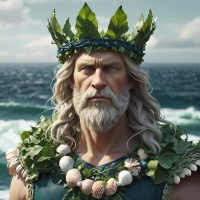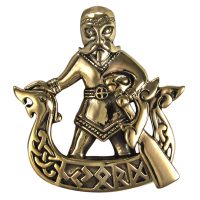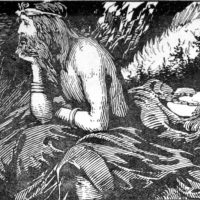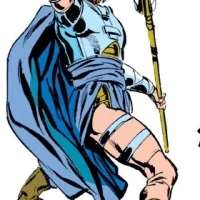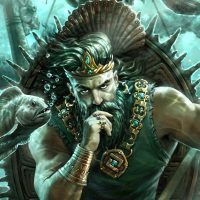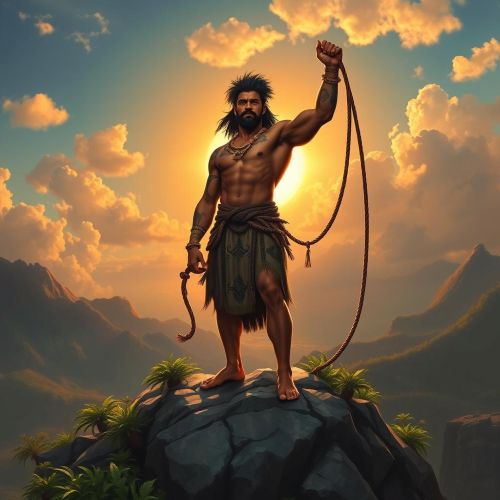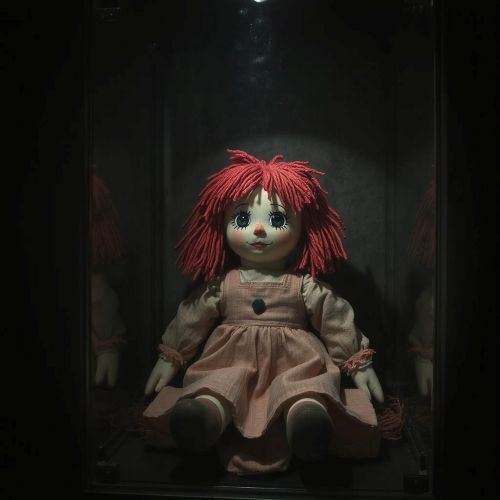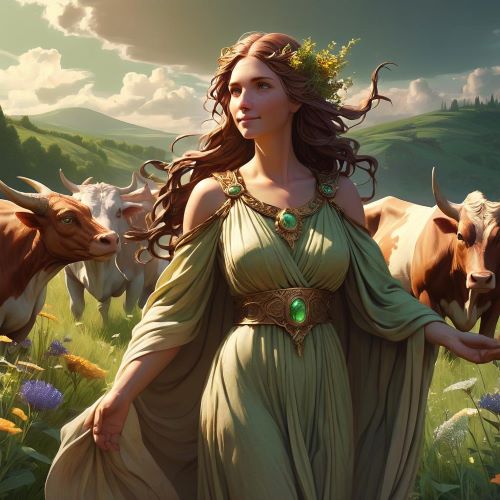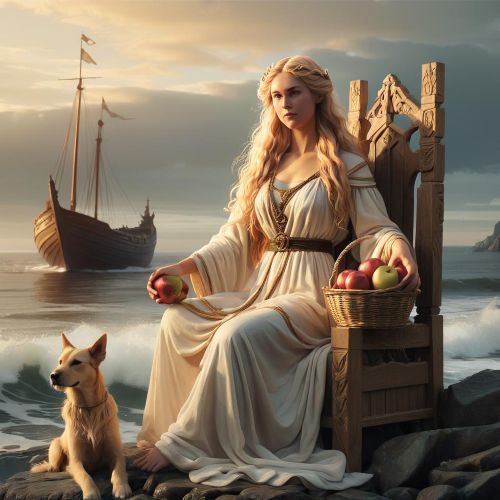Njord : The Sea God
Listen
At a glance
| Description | |
|---|---|
| Origin | Norse Mythology |
| Classification | Gods |
| Family Members | Nerthus (Wife), Skadi (Wife), Freyr, Freya (Children) |
| Region | Iceland, Norway, Denmark |
| Associated With | Sea, Ocean, Fertility |
Njord
Introduction
Njord, a significant deity within Norse mythology, holds sway over the sea, maritime endeavors, and abundant riches. He occupies a prominent place among the Vanir, a tribe of Norse gods renowned for their ties to natural forces and fertility. Unlike the warlike Aesir gods, Njord embodies tranquility, prosperity, and the vital interconnection between humanity and the environment. His enigmatic presence permeates the myths and legends of ancient Scandinavia, symbolizing the boundless expanse of the seas and the wealth they bestow.
Physical Traits
Regrettably, surviving Norse texts offer no explicit descriptions of Njord’s physical attributes. Nevertheless, considering his domains, certain traits can be inferred. As the deity of the sea, he likely embodies a formidable presence reminiscent of an experienced sea captain. His affiliation with wealth and fertility hints at a well-to-do and prosperous countenance. Ultimately, Njord’s corporeal form remains open to interpretation, fostering a more intimate connection between worshippers and the divine. While specifics about Njord’s appearance are scarce in surviving Norse literature, artistic depictions often portray him in association with his domains.
He is commonly illustrated with a flowing beard and hair reminiscent of seafoam, his eyes reflecting the profound depths of the waters under his command. In Norse artwork, Njord frequently stands upon a ship’s prow, symbolizing his dominion over maritime exploration and travel. Adorned with symbols of opulence and abundance, his attire reinforces his connection to wealth and prosperity. Though detailed descriptions may be lacking, Njord’s representations in art offer glimpses into his divine nature and influence over the seas.
Family
Njord’s family dynamics within Norse mythology are intricate and significant, reflecting the ongoing tensions between various divine factions. He is notably the father of the esteemed twin deities, Freyr and Freyja, both celebrated for their roles in fertility, love, and abundance. The identity of their mother remains a subject of speculation, with some suggesting it could be Njord’s unnamed sister, hinting at potential practices of sibling marriage among the Vanir.
In addition to his children, Njord’s marital history adds further complexity to his lineage. As part of a diplomatic exchange aimed at fostering peace between the Aesir and Vanir, Njord found himself in a peculiar marriage with Skadi, a formidable giantess associated with the mountains and hunting. This union, born out of necessity, quickly revealed stark differences in their preferences and backgrounds. Njord longed for the familiar sounds of the sea, while Skadi yearned for the solitude and grandeur of the mountains.
To reconcile their disparate desires, Njord and Skadi devised a compromise, agreeing to spend alternating periods in each other’s domains. However, despite their efforts, the fundamental mismatch between their worlds proved insurmountable. Eventually, their marriage came to an end, highlighting the complexities of divine relationships and the challenges inherent in bridging the divide between disparate realms.
Other names
Njord, like many Norse deities, possesses a multitude of names and epithets that illuminate various facets of his character and realm. Among these, “Njörðr” in Old Norse texts preserves the linguistic nuances of his identity, while the designation as the “Vanir god of the seas” underscores his pivotal role within the Vanir, a distinct group associated with fertility, nature, and mysticism. The etymology of “Njord” traces back to the Old Norse language, with interpretations suggesting connections to concepts of strength or vigor, as well as wealth and abundance, mirroring his association with prosperity and opulence.
Throughout Old Norse literature, Njord’s primary name appears in diverse forms, with variations such as Njörðr and Njordr commonly encountered. Additionally, kennings—poetic phrases used to evoke the essence of deities—further enrich his epithets. Titles such as “God of the Vanir,” “Father of Freyr,” “Wane” (reflecting the Vanir’s association), and “Kinsman of the Vanir” illuminate his significance within the Vanir pantheon and his role as a paternal figure.
Powers and Abilities
Njord’s powers rival the boundless expanse of the sea itself, establishing him as a deity of immense reverence and authority. Primarily revered as the god of the sea, he commands the tumultuous waves, the capricious winds, and the myriad creatures that inhabit the depths. Sailors and fishermen invoke his name for safe passage through treacherous waters, beseeching calm seas and plentiful catches. Yet, Njord’s influence transcends the ocean’s edge, extending inland to bestow fertility upon the coastal lands. Here, he ensures abundant harvests and prosperity for those reliant on the bounty of the earth.
Additionally, Njord’s divine purview encompasses the harmonization of discordant elements. Possessing the power to quell fiery conflicts and mediate disputes, he embodies principles of peace and concord. Thus, Njord emerges as a figure of multifaceted authority, bridging the realms of sea and land, tranquility and tempest, to safeguard the well-being of those who venerate him.
Modern Day Influence
Despite the scarcity of textual descriptions, alternative sources indicate Njord’s widespread veneration among the Norse populace. His prominent position in Norse mythology underscores the integral role of the sea and natural elements in Norse society, essential for their sustenance and prosperity. While Norse mythology has receded into the annals of history, Njord’s enduring legacy permeates modern culture through literature, art, and media. Depictions of Njord serve as a testament to the enduring allure of Norse mythology, captivating the imagination of those fascinated by the mysteries of the sea and nature.
One of the most renowned tales featuring Njord recounts his ill-fated union with Skadi, a story emblematic of the contrasting realms of the Aesir and Vanir. Skadi’s quest for retribution, stemming from her father’s demise at the hands of the Aesir, culminated in her marriage to Njord, chosen hastily and based on a superficial criterion. Their coexistence proved fraught with discord, as Njord found the mountains inhospitable and Skadi abhorred the maritime environment. Despite earnest attempts at compromise, their disparate inclinations ultimately led to the dissolution of their union.
Njord’s enduring influence persists in contemporary society, evident in the plethora of Scandinavian place names bearing his imprint, particularly those in coastal regions. Artists continue to draw inspiration from Njord, immortalizing his likeness in various mediums, from paintings to sculptures. The concept of a benevolent deity intertwined with the sea and nature resonates deeply in an era increasingly preoccupied with environmental consciousness, further cementing Njord’s relevance in the modern world.
Related Images
Frequently Asked Questions
What is lorem Ipsum?
I am text block. Click edit button to change this text. Lorem ipsum dolor sit amet, consectetur adipiscing elit. Ut elit tellus, luctus nec ullamcorper mattis, pulvinar dapibus leo.
What is lorem Ipsum?
I am text block. Click edit button to change this text. Lorem ipsum dolor sit amet, consectetur adipiscing elit. Ut elit tellus, luctus nec ullamcorper mattis, pulvinar dapibus leo.
What is lorem Ipsum?
I am text block. Click edit button to change this text. Lorem ipsum dolor sit amet, consectetur adipiscing elit. Ut elit tellus, luctus nec ullamcorper mattis, pulvinar dapibus leo.
What is lorem Ipsum?
I am text block. Click edit button to change this text. Lorem ipsum dolor sit amet, consectetur adipiscing elit. Ut elit tellus, luctus nec ullamcorper mattis, pulvinar dapibus leo.
What is lorem Ipsum?
I am text block. Click edit button to change this text. Lorem ipsum dolor sit amet, consectetur adipiscing elit. Ut elit tellus, luctus nec ullamcorper mattis, pulvinar dapibus leo.

